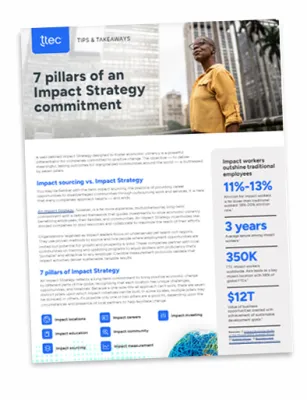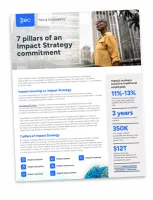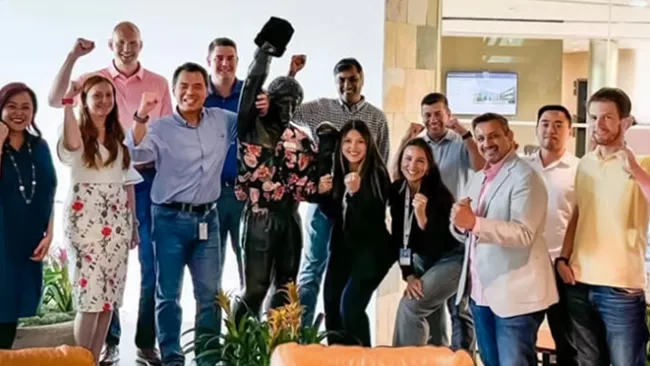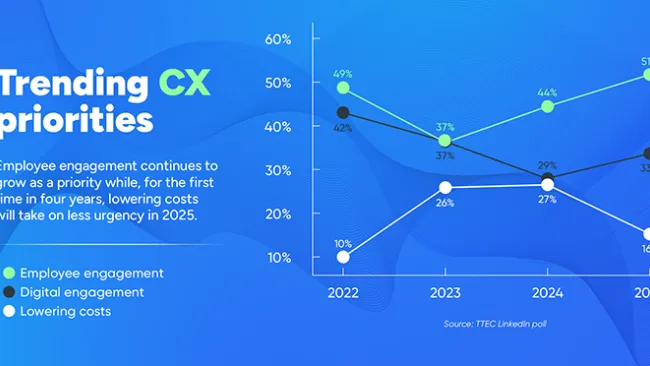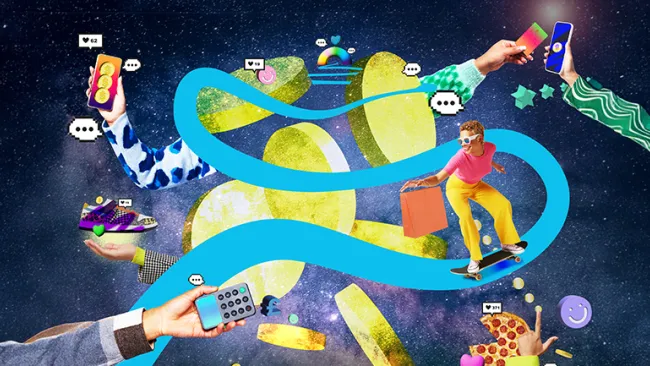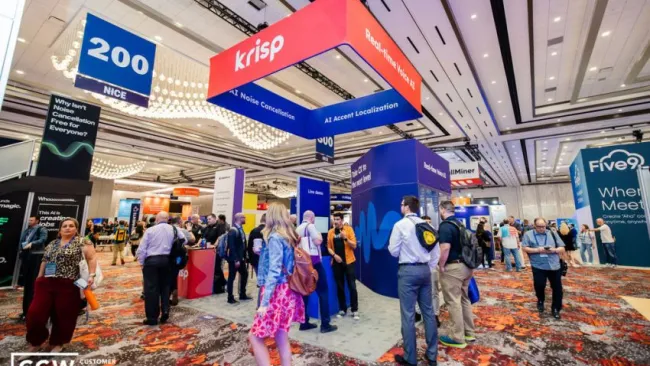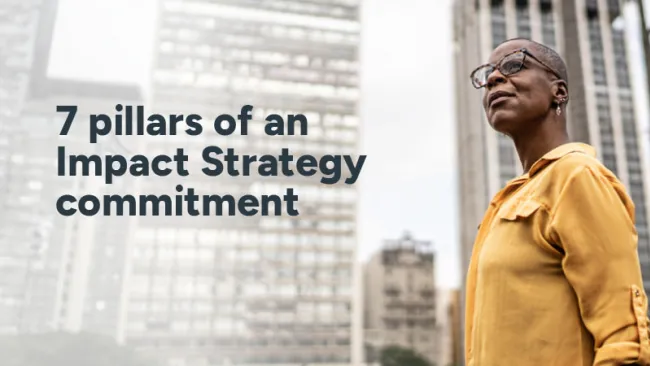The Great Resignation is a topic receiving plenty of attention and for good reason. In a record breaking year, the Labor Department’s Job Opening and Turnover report cited that over 47 million American’s voluntarily quit their jobs in 2021.
And the customer service space is far from untouched. In 2021, Contact Center Central reported that outsourcing vendors saw training class show rates down by half or more. Disengagement and resignations in customer service affects much more than employee happiness or turnover—it often impacts customer interactions and even customer satisfaction with your brand.
Let’s face it, customer-facing employees have the power to tarnish your brand or enhance your brand, which should make keeping them engaged and productive a critical part of your organization’s internal culture and DNA. Yet, we continue to see important initiatives that fall under the employee experience (EX) umbrella fall to the wayside in favor of operational enhancements that do little to improve the employee experience or drive deeper employee engagement.
It’s important to keep in mind that every emerging customer experience challenge we are trying to solve in the post-pandemic digital world reflects a similar employee experience challenge. For customers, you aim to deliver seamless digital journeys that can help customers navigate the digital sales cycle. For employees, you might need to reimagine the onboarding or recruiting journey to better serve a remote workforce’s expectations.
Now for the good news. Due to the shared pain points customers and employees are facing in the post-pandemic world, there is a wealth of proven customer experience (CX) strategies readily available to help your organization solve the employee turnover crisis and re-engage your workforce
If your organization is ready to begin aligning your employee experience with the new world of work, here are five CX strategies that result in great EX:
Strategy #1: Understand your employee journey
When it comes to marketing a product, the customer journey is an integral factor in deciding which touchpoints and messages make sense for a specific customer in a specific moment. The same is true for your employees. Not every employee has the same experience or the same role, which means they will likely need different levels and types of support during the entirety of their employee experience, from onboarding and across their day-to-day duties. Take the time to perform an employee journey mapping exercise that can help you uncover employee personas and pain points found throughout your organization.
Identifying and anticipating common issues and sentiment provides a unique view for every stage of the employee journey. This strategy helps uncover:
- Critical employee issues that be proactively addressed
- Real-time and historical data that identifies current employee behaviors
- Key moments that matter for everyday interactions
Use this insight to build out the right set of touchpoints, messages, policies and cultural norms to make their experience engaging and productive from the beginning. And don’t forget about the employee lifecycle too. Just like a customer, your employees’ needs will change over time. Think about how you can build in career growth and upskilling opportunities that demonstrate an understanding of their long-term goals.
Strategy #2: Provide the right tools to empower employee success
In the CX world, omnichannel strategies allow customers to move quickly through customer service interactions with the right speed and level of touch they require. The key here is the seamless orchestration between each one of these channels that makes true omnichannel engagement possible. For the employee experience, tool selection for the modern world of work is critical.
From a collaboration and communication perspective, cloud-based solutions present an obvious advantage for remote and hybrid work environments to access the digital channels that have become a prolific in everyday life. Using an asynchronous all-in-one platform to message users on the channel of their choice not only caters to the customer’s comfort zone but the employee’s as well.
But, beyond these front-line solutions that powered the early work-from-home shift, organizations should also reconsider many of their longstanding tools as well—such as CRM and data management platforms.
By integrating the right mix of APIs and add-ons to legacy tools, employers have a powerful opportunity to shift routine tasks off their employees’ to-do list via automation and machine learning, which can enable them to be more creative and to prioritize the high-touch interactions that help close a new sale or wow an existing customer.
Supercharging employees with automation is not only about giving them the right tools, but also the right education. Like cloud capabilities, an automated knowledge management system can break down siloes and roadblocks to spread relevant information among employees. Capturing the right information in a safe space encourages healthy collaboration between employees, leadership, about the latest best practices and capabilities to serve customers.
Strategy #3: Listen to your employees and create a feedback loop to promote long-term alignment
Your employees know exactly what they need to best serve customers. So, while the first two strategies represent useful approaches to play “catch up” or build an employee experience that meets existing needs, remember these needs aren’t static. It’s critical to stay in tune with employee expectations moving forward.
After all, failure to maintain alignment with employees is partially to blame for the current wave of resignations. In 2021, research from UKG revealed that 86% of employees surveyed felt people in their organization weren’t heard fairly or equally and nearly 50% felt that underrepresented voices remained undervalued.
Developing an official Voice of the Employee (VoE) program is a great way to address this disconnect head-on. The best VoE programs integrate a mix of:
- Employee surveys to gather general information on customer-facing staff members (note that too many surveys may result in sub-optimal information)
- Active listening that devotes time to explore and connect on common issues from both an employee and customer perspective
- Rewards programs that incentivize your employees to share feedback and go the extra mile to provide amazing support
- Close the loop activities to make sure employees know that they were heard and that there is action being taken based on the feedback. Without a close the loop set of activities, employees may begin to believe that the VoE program is simply window dressing.
Together, these three methods can identify common pain points that take place across the full employee experience and remedy them before they create a turnover problem. The best business leaders understand that listening must be followed with action. Employees want their concerns to be addressed, not only heard.
Strategy #4: Build a culture of recognition, reward and respect
Amid building pressure to do more to remedy staff shortages and employee stress, it is more important than ever to recognize individual contributions. Even those tasks that might be considered a normal expectation of the job have become increasingly difficult for a myriad of different external reasons outside of the employees’ control.
As a result, make sure you provide recognition for above-and-beyond service to:
- Show that you are paying attention
- Demonstrate that you don’t take great customer service for granted
- Celebrate good work
It’s essential to foster a deep respect for employees’ points of view, opinions, and ideas. The beauty of remote work is its ability to create a community of various backgrounds and beliefs. This not only encourages a more inclusive environment, but also allows human beings to learn and develop.
Make sure that the recognition program allows for both formal and ad-hoc recognition. Both are powerful to motivate and engage employees
If you want to grow and sustain employee engagement, fostering a culture of respect can have an immeasurable payback for employee well-being and brand perception.
Strategy #5: Inspire and lead with purpose
Customers prefer to shop with brands that stand for something. In the research report The 2020 Zeno Strength of Purpose, consumers who think a brand has a strong sense of purpose are four times as likely to make a purchase and six times more likely to protect them in the event of a misstep. And from our perspective, the same goes for employees. Leaders must create and foster dialogue regarding their mission and how they are not only making customer’s lives better but employee’s as well.
Ensuring that a mission is made clear to customers and employees is not the only division. Organizations must make their purpose transparent for in-office and remote employees. Remember, employee disconnect is a big factor in the Great Resignation, so make sure you don’t close the door on those that are only connected digitally.
Conduct CX and EX in perfect harmony
Improving or transforming your employee experience is often easier than you might think. In many cases, relatively small changes can have a tremendous impact on the day-to-day satisfaction and engagement of your employees.
When your CX and EX strategies work in unison, you’ll quickly recognize that your organization can take customer service to new heights.


